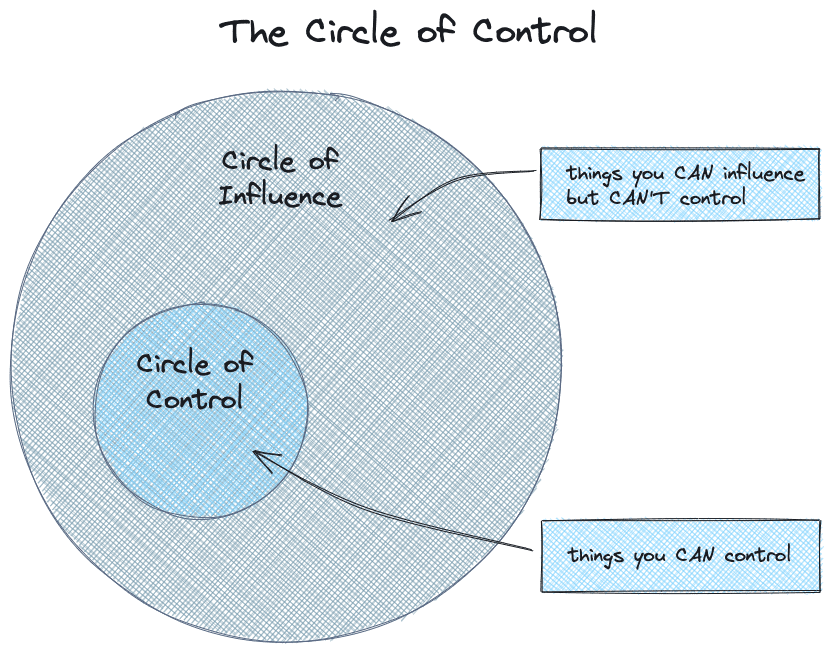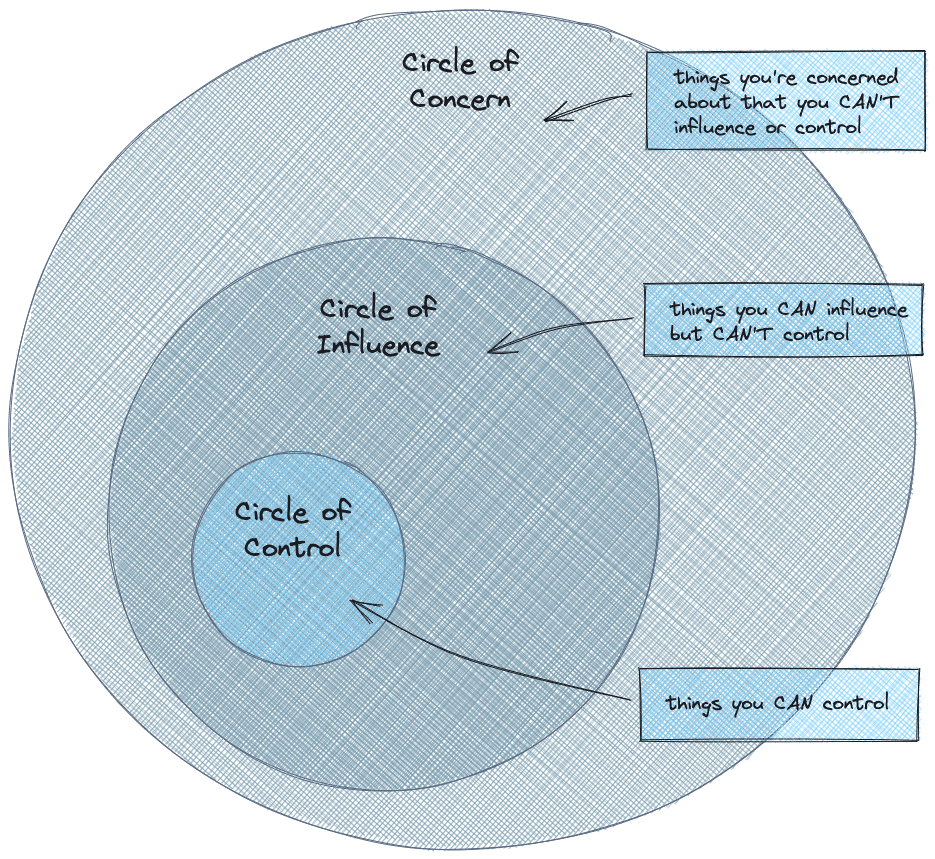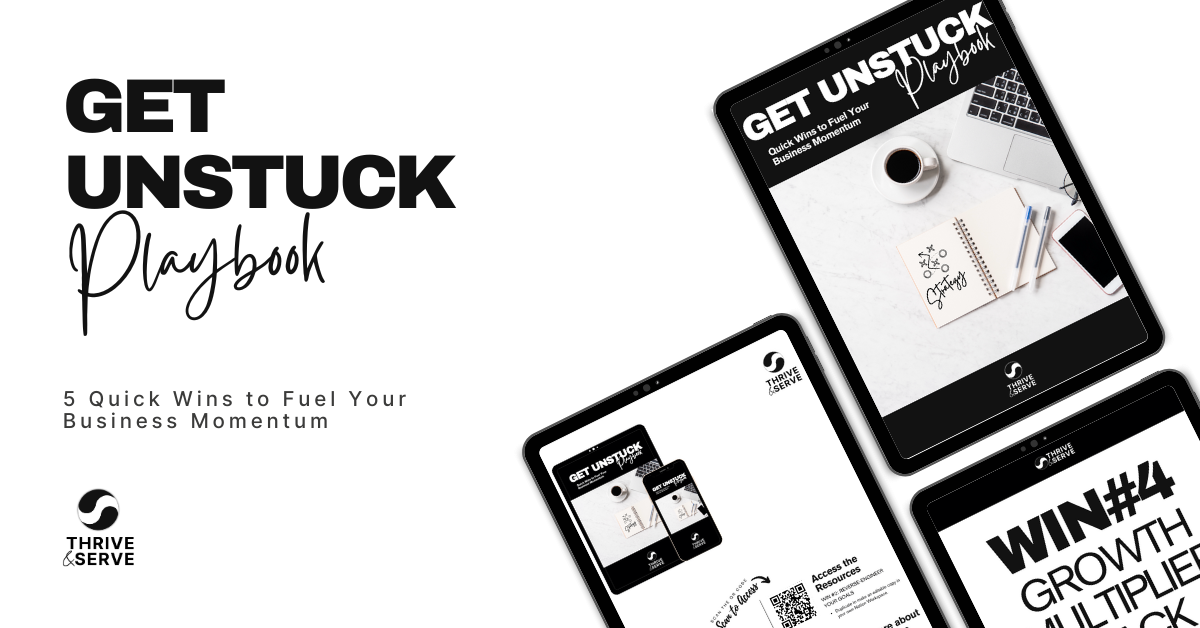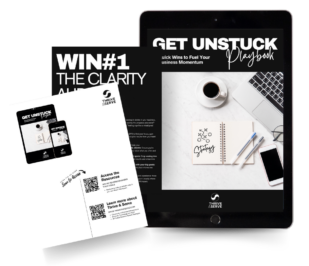What is the Circle of Control?
The circle of control is a concept that refers to the things in your life that you have the power to change or influence. It is a way of thinking about your life and responsibilities that helps you to focus on what's within your control and let go of things you can't control.
The circle of control is often represented visually as two circles, with the things that you have control over inside the inner circle and the things that you don't have any control over in the outside circle. This can be a helpful way to think about how to allocate your time and energy and identify the things you spend unnecessary time worrying about.

Why is the Circle of Control Important?
By focusing on the things that are within our circle of control, we can take an active role in shaping our life and creating the outcomes that we want. This can help you to feel more empowered and in control of your circumstances.
On the other hand, trying to control things that are outside of your control can be frustrating and ultimately futile, so it's important to recognize these limitations and stop worrying about things outside your inner circle.
This can lead to increased satisfaction and well-being and can help us to feel more confident and capable of tackling challenges and achieving our goals. This can be instrumental to the success of an entrepreneur.
The Circle of Concern, Influence, and Control
The concept of the circle of control is often associated with Stephen Covey and his book "The 7 Habits of Highly Effective People." In this book, Covey introduces the idea of the circle of concern and the circle of influence as a way of thinking about the different areas of responsibility and control that we have in our lives.
The circle of control is the innermost circle, representing the things that we have direct control over. These are the things that we can change or influence directly, such as our thoughts, emotions, and behaviors.
Covey suggests that highly effective people focus their time and energy on the things within their circle of control rather than trying to control things outside of their sphere of influence.
The circle of concern, influence, and control is a model that helps to clarify the different areas of responsibility and levels of control we have in our lives.

It consists of three concentric circles:
- The outer first circle represents the things within our circle of concern. We care about or impact us in some way, but we don't have direct control over these things. Examples might include global events like a pandemic, other people's actions, or natural disasters.
- The middle circle represents the things within our circle of influence. We can impact or change these things through our actions, but outside factors may still influence them. Examples might include our relationships, work, or personal habits and behaviors.
- The inner smaller circle represents the things that are within our circle of control. These are the things that we have the power to change or influence directly. Examples of things like our thoughts, emotions, and behaviors.
Once you've identified the things within your circle of control and taken action to address them, you can expand your sphere of influence and your circle of control. This might involve taking on new challenges, building new relationships, or seeking out opportunities to make a difference in areas outside your current sphere of influence.
As an entrepreneur, to expand your sphere of influence, you might consider:
- Building relationships with key stakeholders or influencers who can help you to achieve your goals.
- Developing new skills or knowledge that will enable you to take on new challenges or responsibilities.
- Seeking out opportunities to collaborate with others and work together to achieve common goals.
- Building a reputation as a thought leader or expert in your field can give you a greater platform to influence others.
As you expand your sphere of influence, you may also find that you are able to increase your circle of control as you gain the ability to influence and shape more aspects of your life and work. This can help you to feel more in control of your circumstances and more empowered to create the outcomes you want.
How to Apply the Circle of Control to Your Business
There are several ways that you can apply the concept of the circle of control to your business:
- Identify the things that are within your circle of control: Start by making a list of the things that are within your control as a business owner or leader. These might include your business strategy, team, finances, and products or services.
- Focus on what you can control: Once you've identified the things that are within your circle of control, focus your time and energy on these areas. This means setting clear goals and taking action to achieve them rather than getting caught up in things outside your control.
- Make a plan: Develop a plan for how you will address the things that are within your circle of control. This might involve setting specific targets, establishing systems and processes, or developing new products or services.
- Communicate your plan: Share it with your team and other stakeholders, and ensure that everyone understands their role in helping you achieve your goals.
- Monitor and adjust: Regularly review your progress and make adjustments as needed. This might involve adjusting your goals or strategies or taking new actions to achieve your objectives.
By focusing on the things within your circle of control and taking an active, proactive approach to your business, you can create the outcomes you want and achieve success.
Focus on Things you Can Control
There will always be things beyond your control that can waste your precious time and energy. Use the circle of control to figure out what aspects of your life and business you don't have control over. Place these in the big circle or outer circle. This helps us to visually see the things we can't control.
Focus on controlling the controllable, let everything else go.
Colin Scotland
Now, focus on the circle of things we can control. Things within this circle are what we can directly control and influence. You need to focus on what you can actively control. By understanding these different circles of concern, influence, and control, we can identify the areas where we can make a difference and focus our efforts accordingly.
This can help us feel more in control of our lives and more empowered to create the outcomes we want.
Try it yourself. When we let go of things outside our control, the stress and anxiety will begin to melt away.
Final Thoughts on Applying the Circle of Control
Your work is on yourself (your circle of control,) and the work you put out into the world, this in turn expands your circle of influence.
The circle of control is your inner work, and the circle of influence is your outer work.
Work daily on both of these.
Grow your mind, expand your thinking, and elevate your level of consciousness, cultivate self-awareness.
Work to create intellectual property around your inner work and publish this in the outer world.
I have a motto for this. I call it Create Every Day!
These artifacts (content) make up your marketing ecosystem, your footprint, and the things you will leave behind.
Share your experiences with others so they too can benefit. In doing so you will increase your circle of influence.
Other people see you through your work and they form impressions and opinions of you. Seek to make the best impression by being the best version of yourself you can be.
Colin SCotland
You can’t change how others think or what they do, you can change how you show up.
When you become a successful coach and influencer through inner work, your outer circle of influence will also increase. You will attract more clients into your world. You will increase your impact.
Everyone wins.





